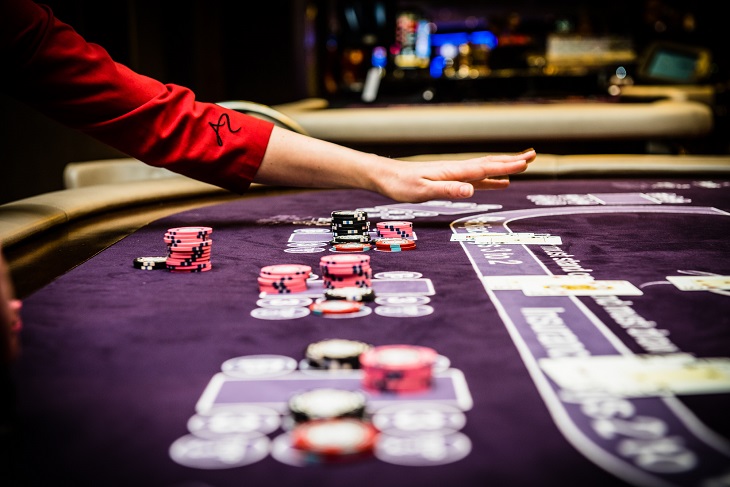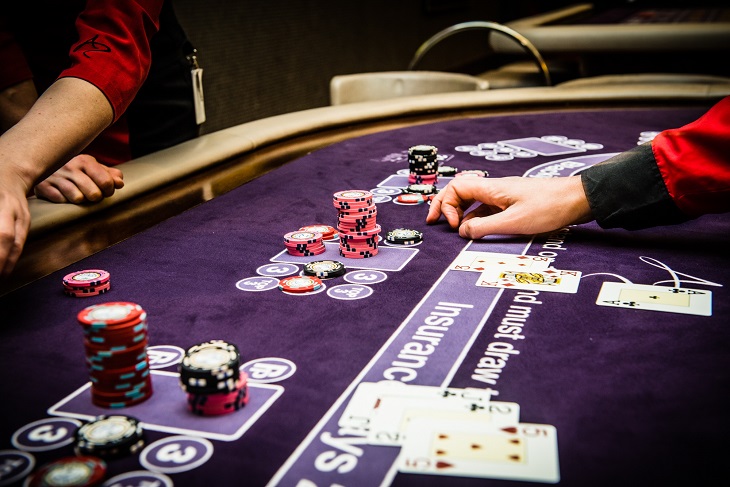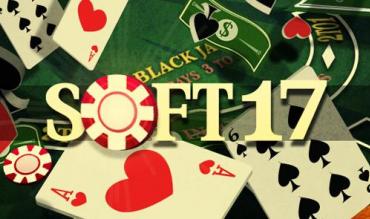One of the hands that often confound blackjack players is when they are dealt a soft 17. Should I stand or hit? What about doubling down? What follows are the facts on how to play this hand accurately every time you play blackjack.
First, let me review some basics. A soft hand is any hand that contains an ace that is counted as 11. For example, an ace-6 is a soft 17; so is ace-3-3 and 2-2-ace-2. The basic playing strategy for, say, an ace-6 is much different than it is for a 10-7 (known as a hard 17 because It doesn’t contain an ace counted as 11). Yes, both hands total 17, but you play a soft 17 differently because you can never bust with a one-card draw (not so with a hard 17).
Regardless of whether you are playing blackjack in a land-based or online casino, when you are dealt a soft 17, if you are not counting cards, you should always follow the basic playing strategy, which is as follows.
WHEN YOU ARE DEALT A SOFT 17:
- Never stand
- Double down when the dealer’s upcard in 3 through 6 (2 through 6 in a single-deck game)
- Hit when the dealer shows a 2 or 7 though ace (for single-deck, double against a dealer 2 rather than hit)
STANDING ON SOFT 17
The basic blackjack strategy for standing on soft 17 is simple: never stand! That’s right; you should never stand on soft 17 regardless of what the dealer’s upcard is. That might seem odd since most players believe that 17 is a good enough hand on which to stand. In fact it’s not because you will lose more money standing than either hitting (or doubling).
"If you remember just one thing from this article it’s this: never stand on soft 17!"
If you are still not convinced that standing on soft 17 is a bad play, think about the dealer’s rule for soft 17. When the casino rules specify that dealer’s must hit their soft 17 (rather than stand), the house edge increases, meaning hitting a soft 17 is better for the dealer than standing. It’s the same for players … hitting soft 17 is always better than standing.
DOUBLING DOWN ON SOFT 17
Many players pass up the opportunity to double down because they don’t understand the logic for doing so. The reason you double on soft hands is not so much to outdraw the dealer as it is to get more money on the table when the dealer is vulnerable to busting. The latter occurs more often when the dealer shows a low-value upcard (e.g., 3 through 6).
The basic strategy for doubling a soft 17 is easy to remember.
- For double- and multi-deck games, double down when the dealer’s upcard is 3 through 6.
- For a single-deck game, double down when the dealer’s upcard is 2 through 6.
MULTI-CARD SOFT 17
Sometimes you might hit your hand and after drawing one (or more cards) have a soft 17. For example, suppose you were dealt a 2-4 and the dealer’s upcard is a 6. You hit and draw an ace giving you a soft 17 (2-4-A). The playing rules in most land-based and online casinos prohibit you from doubling down on a hand once you draw a third card; therefore, if you hold a multi-card soft 17, you should hit.
Likewise, the rules in some land-based and online casinos allow players to double down only on hard hands (i.e., they are prohibited from doubling soft hands). In addition, the rules in most video blackjack games in land-based casinos don’t allow players to double down on soft hands. So, the bottom line is this:
- If you have a multi-card soft 17 or the rules don’t allow soft doubling, always hit soft 17.

HITTING SOFT 17
The basic strategy rules for hitting soft 17 are as follows:
- For double- and multi-deck games, hit when the dealer‘s upcard is a 2 or 7 through ace.
- For a single-deck game, hit when the dealer’s upcard is 7 through ace.
After you hit a soft 17, what you do next depends upon the total of your hand and the dealer’s upcard. (You need to refer to a basic strategy table for the rules on how to play your hand depending upon your total and the dealer’s upcard.)
BASIC STRATEGY TABLE FOR SOFT 17
The following color-coded blackjack strategy table summarizes the above rules for playing a soft 17.
Note:
Dh = Double down if permitted, otherwise hit.
H = Hit
Soft 17 Double- and Multi-Deck Basic Strategy
Dealer’s Upcard
| 2 | 3 | 4 | 5 | 6 | 7 | 8 | 9 | 10 | A |
| H | Dh | Dh | Dh | Dh | H | H | H | H | H |
Single-Deck Basic Strategy
Dealer’s Upcard
| 2 | 3 | 4 | 5 | 6 | 7 | 8 | 9 | 10 | A |
| Dh | Dh | Dh | Dh | Dh | H | H | H | H | H |
QUIZ
To be sure you know when to hit or double-down on soft 17, decide how you would play each of the following hands against the dealer’s upcard.
- A-6 vs. 3
- A-6 vs. 9
- A-2-4 vs. 4
- 2-3-A-A vs. 2
- A-6 vs. 2
- A-6 vs. 5
- A-6 vs. 6 (rules don’t allow doubling)
- A-6 vs. 7
Answers:
- Double down
- Hit
- Hit
- Hit
- Double down in single-deck; hit in double- and multi-deck.
- Double down
- Hit
- Hit
CARD COUNTING AND SOFT 17
Card counters will sometimes vary their playing strategy depending upon the count; however, it’s rare when a card counter deviates with a soft 17 because there’s not much to be gained. The two times a card counter might consider doing so is as follows:
- If the count is positive, double down on soft 17 against dealer’s 2 upcard
- If the count is negative, hit against dealer’s 3 through 6 (rather than double down).
To be accurate, you should consult a table of index numbers for whatever counting system you are using for the specific index number for the above two plays.
